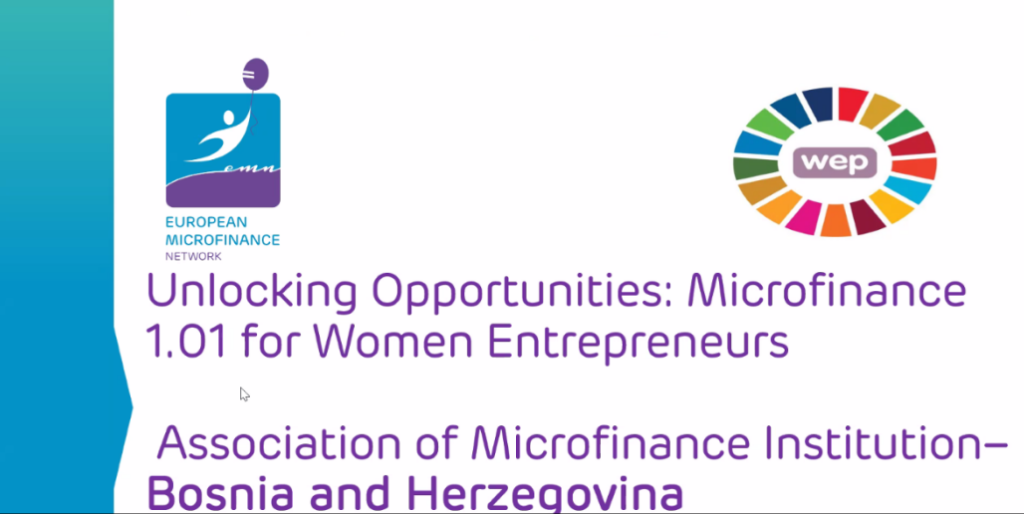On 29 April 2025, the European Microfinance Network (EMN), in collaboration with the Women Entrepreneurship Platform (WEP), held a pivotal webinar titled “Unlocking Opportunities: Microfinance 1.01 for Women Entrepreneurs.” The event brought together field practitioners, institutional representatives, and advocates for gender equality in finance to explore the potential of microfinance as a tool for women’s empowerment across Europe and beyond.
Bridging the Gender Gap in Access to Finance
Opening the session, Charlene Lambert, Treasurer of WEP and an advocate for women’s economic leadership, outlined the persistent challenges facing female entrepreneurs. Despite women representing 52% of the EU population, only 34.4% of the self-employed are women. Access to finance remains a significant barrier, particularly in risk capital. In 2024, fully female-founded teams in the UK received only 1.8% of the €9.5 billion in equity investments, compared to 86% going to all-male teams.
Yet research reveals a missed opportunity: female-led tech teams generate a 35% higher return on investment than male-led teams. WEP, an international non-profit based in Brussels, promotes women’s entrepreneurship by aligning policy advocacy, facilitating knowledge-sharing networks, and advancing access to resources through five key pillars: government policy, innovation, access to finance, education and training, and networks.
Case Study 1: NOA (Albania) – Microfinance for Inclusion and Economic Revival
The first case presented was NOA, Albania’s leading non-bank financial institution. With 26 years of experience, NOA is recognized for its inclusive and community-driven approach. Its CEO, Besart Kadia, has led the organization’s transformation to include digital branches, biometric identification systems, and partnerships with rural business networks. NOA currently operates 30 branches, employs 350 staff members, and manages a loan portfolio of over €110 million, with an average loan size of €6,070.
In terms of gender impact:
58% of NOA’s staff are women.
Women hold 53% of senior management positions.
26% of business loans are directed to companies owned or managed by women.
34% of individual loans support women investing in household improvements, business tools, or self-employment.
Stories of women like Genta, the first female wooden boat builder in Albania, or Nebije, a traditional artisan creating jobs for local women, highlight NOA’s tangible impact in empowering women entrepreneurs, many of whom return from abroad to reinvest in their communities.
Case Study 2: AMFI (Bosnia and Herzegovina) – Building an Inclusive Financial Ecosystem
The second case came from AMFI, the Association of Microfinance Institutions in Bosnia and Herzegovina, presented by Executive Director Eldina Mehić. AMFI represents 31 microfinance institutions (MFIs), employing over 2,300 people and serving over 280,000 users, reaching nearly 20% of the country’s population.
Gender inclusion is deeply embedded in the sector:
68% of the microfinance workforce are women.
32% of MFI directors are women.
29% of women hold top management positions, and 40% hold middle management roles.
The sector has disbursed more than €4.5 billion, with 45% going to women.
The microfinance sector in Bosnia also plays a crucial role in supporting low-income entrepreneurs and survivors of domestic violence. Programs combine financial literacy, mentorship, and psychosocial support, offering business opportunities and a pathway to dignity and independence.
AMFI also plays a regional leadership role as co-founder of the Western Balkans Microfinance Alliance and spearheads gender-oriented initiatives like the Wi-Fi CODE, a gender-smart services project supported by the European Bank for Reconstruction and Development (EBRD) and the Central Bank of BiH.
Key Takeaways and Conclusions
The event concluded with strong shared recommendations:
Data Matters: Financial institutions must systematically track gender-disaggregated data to identify gaps and design effective solutions.
Tailored Products: One-size-fits-all financing does not work. Women need accessible, flexible loan structures, often with minimal collateral requirements.
Mentorship and Education: Building financial literacy and business acumen is essential, especially for rural and low-income women.
Partnerships for Impact: Joint efforts between financial institutions, women’s organizations, and policymakers amplify outcomes.
Support Survivors: Microfinance must also address social vulnerability. Supporting women survivors of violence through business advisory and microloans can break cycles of dependence and create new futures.
Policy Advocacy: EMN and WEP reaffirmed their commitment to shaping EU-level policy promoting inclusive entrepreneurship.
A Shared Mission: Finance that Works for Women
As participants agreed, microfinance is not just about access to money but also dignity, growth, and autonomy. The examples from Albania and Bosnia and Herzegovina show that gender-inclusive microfinance models exist, work, and can scale.
Empowering women entrepreneurs means unlocking individual potential and broader economic and social prosperity. As stated in the European Commission’s 2014 communication:
“Encouraging the creation of more women-led businesses will not only bring fresh and creative business ideas but will also empower the role of women in society and create new sources of prosperity and jobs.“


